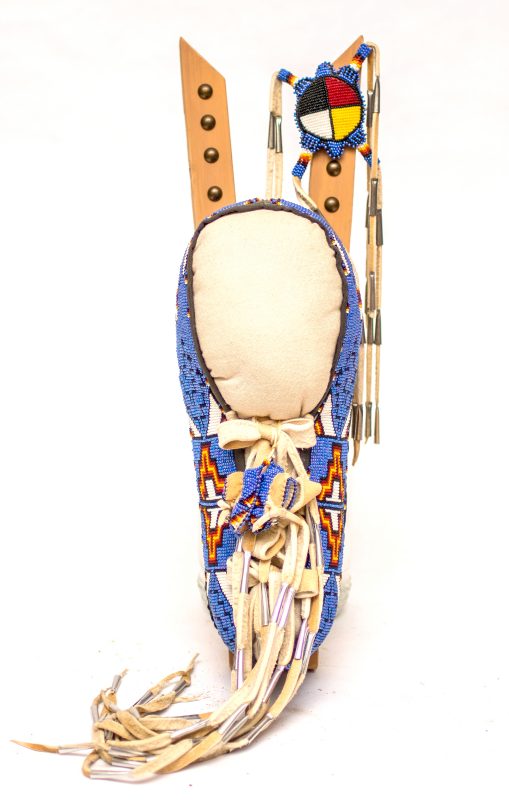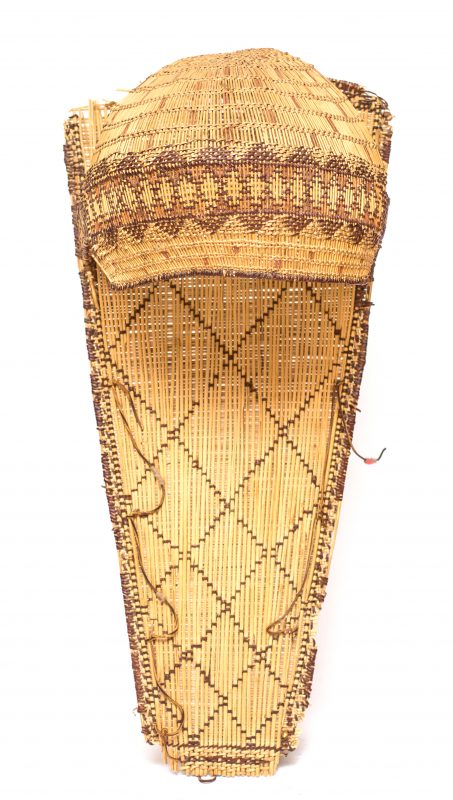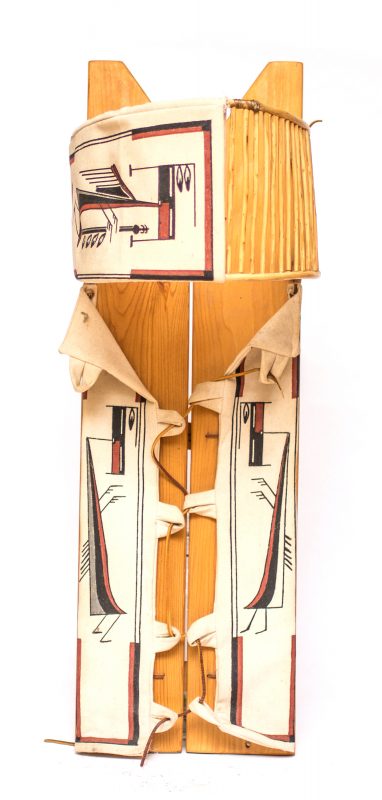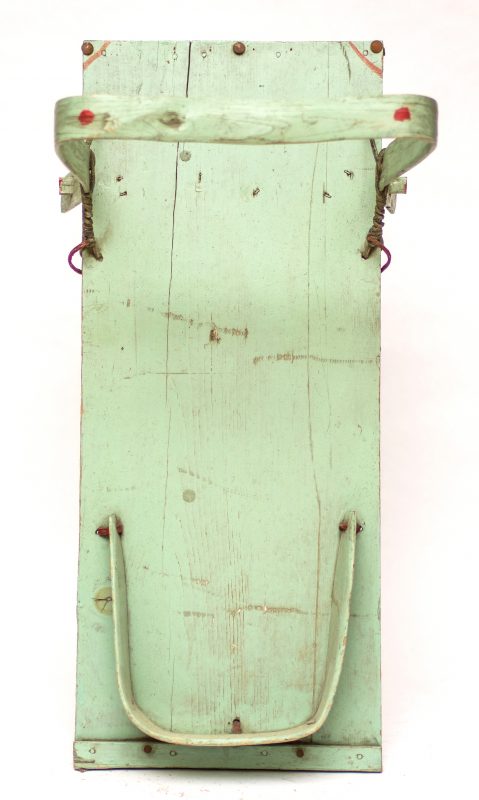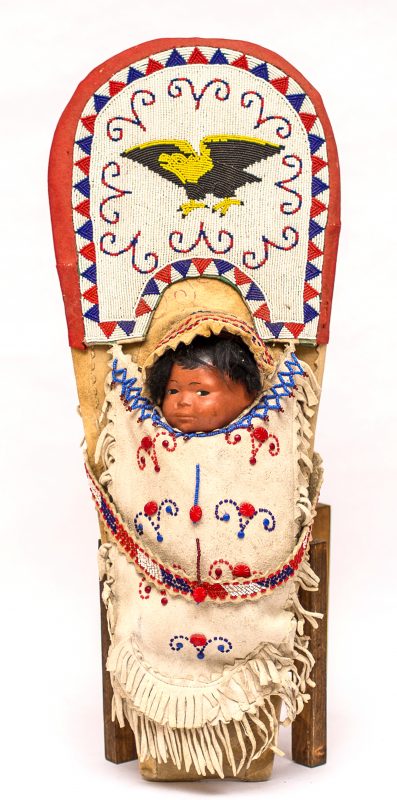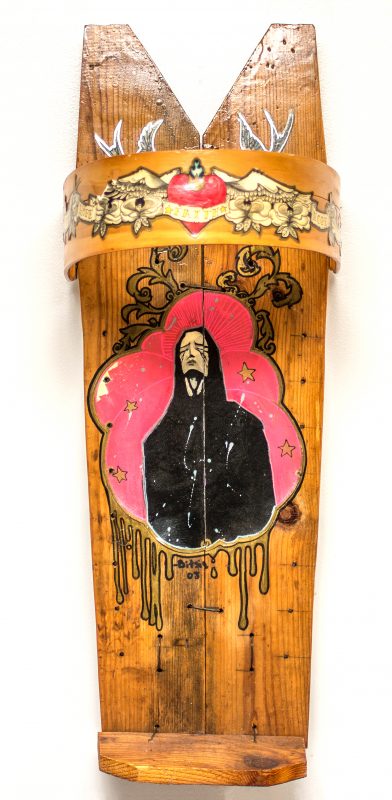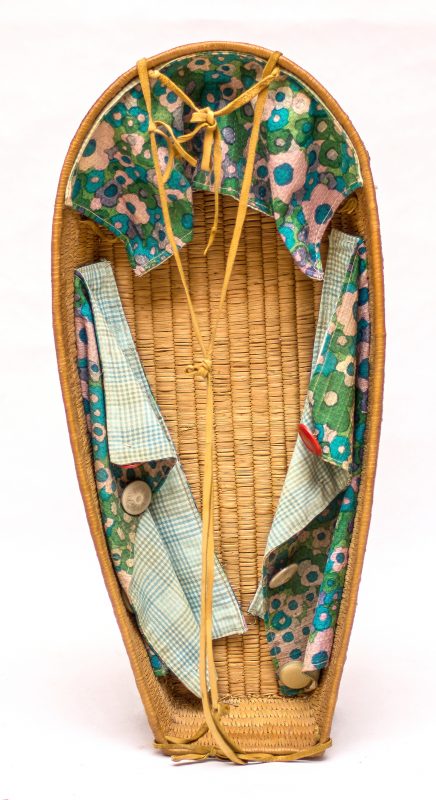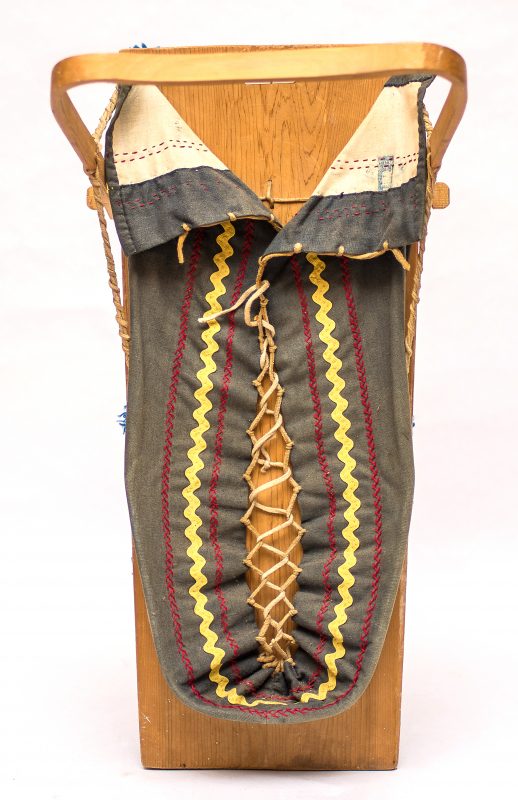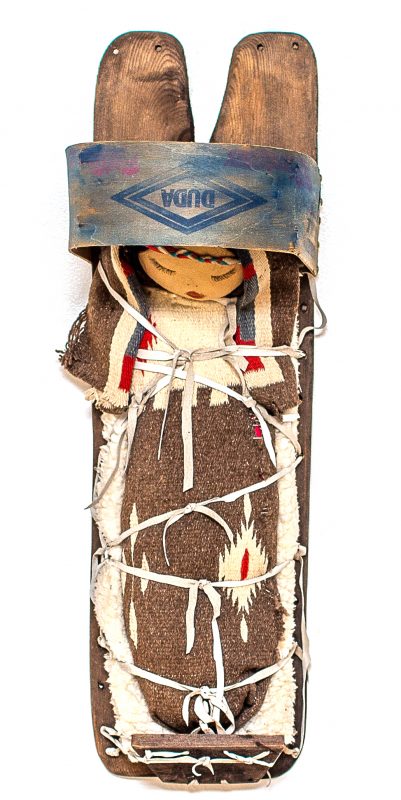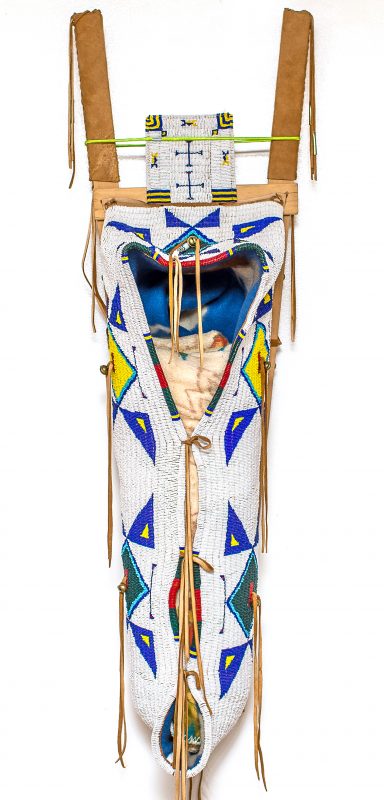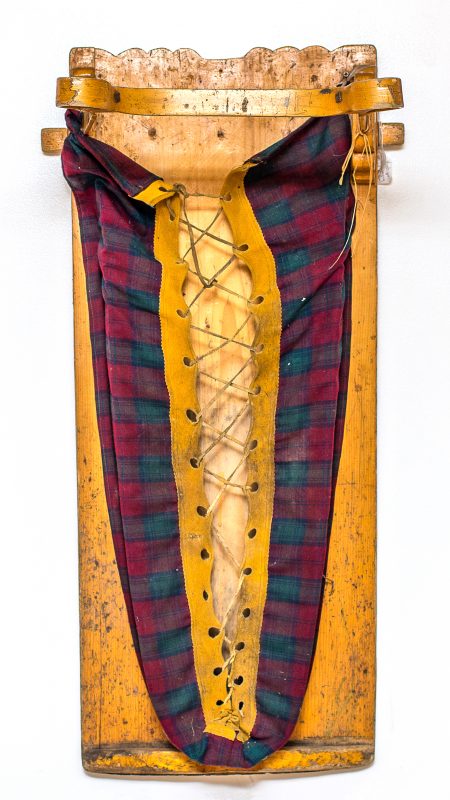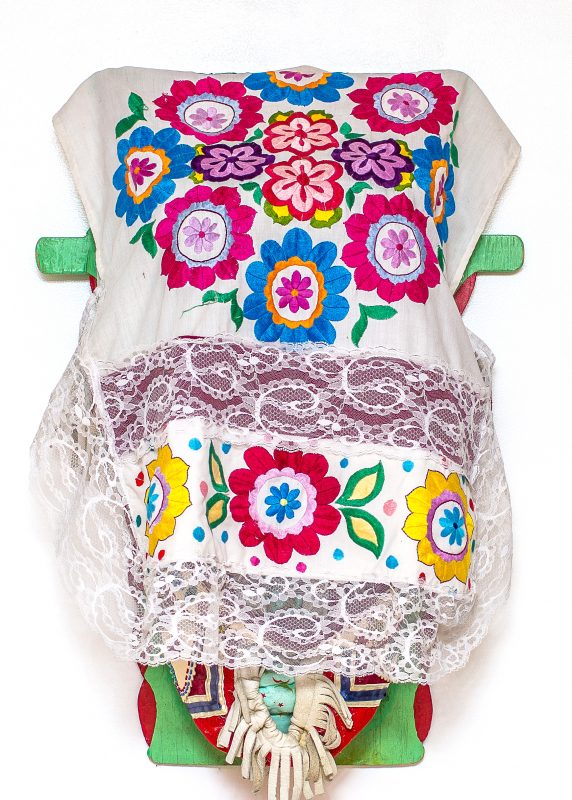Dakobinaawaswaan (Baby in a Cradleboard) gathers more than 150 cradleboards representing Indigenous communities from across Turtle Island. In the language of Aninishaabeg peoples, dakobinaawaswaan describes a baby being wrapped and placed in a cradleboard, or tikinagaan. This exhibition showcases the strong legacy and beauty of traditional baby carriers — including miniatures, toy cradles and baskets — of the many Indigenous communities across North America. Through a wide range of imagery, beadwork, and specialized materials the cradleboard is honoured as a vessel of motherhood, cultural traditions, community, and resurgence.
Brought together by Shirley Stevens and the Cradle Keeper Co-operative of Northwestern Ontario, this exhibition is dedicated to the late Freda McDonald, the Elder for this initiative, who encouraged the project from the beginning.
curated by
Caitlyn Bird
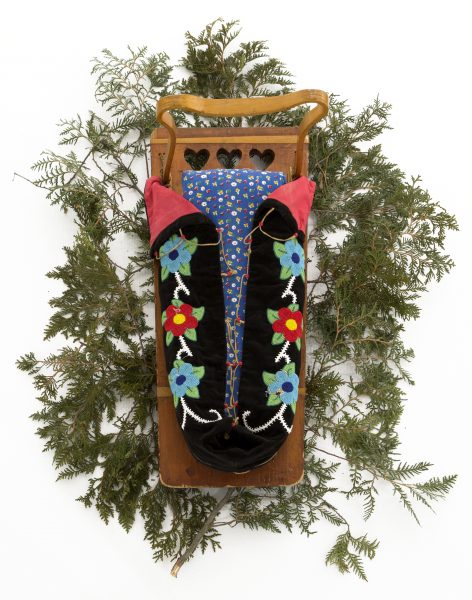
Nowegijick family Tikinagaan, Paul Shonias, Kiaashke Zaaging (Gull Bay First Nation)
“Teach the children”
— Freda McDonald
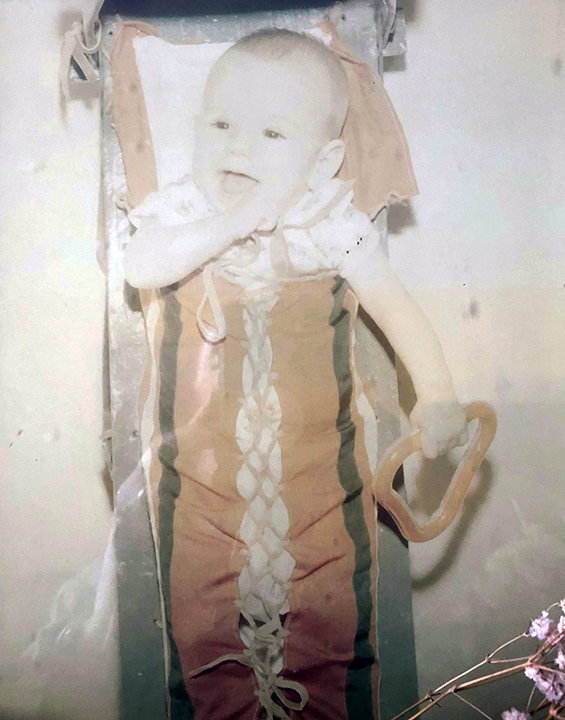
COMMUNITY CRADLEBOARDS
As part of Dakobinaawaswaan (Baby in a Cradleboard) we want to create new connections with Indigenous communities across Turtle Island.
We welcome you to share a photo of your tikinagaan or cradleboard along with your special story and family history. We will post the image and whatever information you feel comfortable sharing in an online gathering of cradleboards.
Please send your images and info to:
GREAT LAKES
In the Great Lakes region, the environment is staggering. Many of the tribes such as the Anishnaabeg people were nomadic according to the seasons. Cradleboards were innovative for survival on the land and travelling long distances with babies. Natural materials such as hard wood and birch bark were essential to the design of the cradleboard.
Cradles of the Great Lakes communities such as Anishnaabeg, Cree, and Haudenosaunee and Métis share similar cradleboard features, for instance, the use of bows. Although similar, they are unique in their own style and imagery.
Two common types of tikinagaans of the Anishnaabeg use backboards of cedar or birch bark. An important part of the tikinagaan design is the moss bag, which is used to wrap a baby before putting them into a cradleboard. This is very beneficial for the baby as it also provides first lessons of life such as love, discipline, and protection. The design elements often include floral imagery representative of the land and family design.
NORTHWEST COAST
The Northwest Coast communities such as Haida Gwaii and Tlingit are situated on the Pacific Coast, including islands and archipelagos.
Natural materials like cedar and roots are commonly used for the cradles. Through specialized weaving techniques, basket cradles are fashioned with imbricated (overlapping) cedar strips dyed using a natural root.
Renowned for their bentwood box techniques, artists have the Northwest Coast have applied these skills to cradles. The bentwood box cradle displayed here is an oval shaped box with seven sides and a defined top piece. This technique involves using a continuous piece of wood shaped with steam. Having only one seam helps to make the cradleboard waterproof.
PLAINS
First Nations of the Plains include the Lakho’ta (Lakota), Apsáalooke (Crow), Tsitsistas (Cheyenne), Numunuu (Comanche) and many more, are distinguished by their fully beaded cradles. Backboards, parfleche, and smoked, tanned hide are highly decorated with natural materials such dyed porcupine quills and traditionally traded goods such as beads and brass. Geometric designs, as well horses and buffalo are common motifs that depict cultural values and represent family histories.
Some of the cradles have stylized wooden bars or slats. It is believed this style of cradle originated from one tribe and spread naturally to others. This design was useful for hanging on a saddle or for leaning against trees.
There are several soft cradles that are fully beaded and beautifully embellished with ribbons, bells, and elk teeth. Many soft cradles are also detachable from their wooden backboard. Owning or making a fully beaded soft cradle was a great source of pride for mothers, families and communities; it was a way to honour the baby while demonstrating artistry and skill.
PLATEAU
The Plateau region represents communities including Yakima (Yakama), Nimipuutímt (Nez Perce), Schitsu’umsh (Coeur D’alene) and Sélis (Salish) coastal communities. The Plateau is located in-between two mountain ranges inland from the Pacific West Coast.
Cradleboards of the Plateau are highly distinguished by the use of natural and trade materials such as beads and textiles. Generally, the backboard has an elongated, oval shape. There are two different designs for hoods. One features a woven hood made from twigs that usually incorporates the use of beads. Another design has a moveable bow for convenience. The board is often covered with hide decorated with beadwork across the top and embellished with strings of hide.
CALIFORNIA
First Nations in California such as Nyyhmy (western Mono Lake Paiute) Pomo, Numa, and Nuwui are well-known for their intricate woven patterns made from natural materials such as willow, twigs, marsh grass, and reeds.
Weaving techniques for these cradles are brilliant and innovative. The decorative element of an intricate, tightly woven pattern speaks to cultural customs and relationship with the land. Prior to making the cradle, members of the community gathered and prepared materials. For instance, when gathering twigs, care and attention went into cutting, shaping and bending the materials before putting the cradle together.
Many of these cradles look delicate but they are extremely strong and durable. A design feature is a patterned, woven hood that protects a baby from the sun, wind, and heat. In this region, there are two types of cradles; one is a “receiving cradle” for newborns with a woven bow. A child grows quickly into another style of cradle which has an intricate designed woven hood.
SOUTHWEST
Throughout regions of New Mexico and Arizona, First Nations such as the Diné (Navajo), N’dee (Apache) and Pueblo communities (there are 19 Pueblo groups) have distinctive cradles made with materials from their natural surroundings including cedar, pine, and grasses.
Of the many cradleboards from these communities, there are swing cradles, twig cradles often covered with fabric and or hide, cedar cradles, and Diné cradleboards with a wooden bow (the curved wood bar attached to the board). In Diné communities, there is a ritual associated to finding the perfect cedar wood for the cradleboard. For instance, a tree hit by lightning was the most sought-after for making a cradle.
Indigenous communities across North America have different cultural practices associated with cradleboards. In harvesting natural materials, ceremony and offerings are often made in appreciation to the land and all that it gives.
THE NORTH
Covers a vast area above the Great Lakes including many fly-in communities of the Anishinaabeg, in Northern Alberta and Saskatchewan, The Northwest Territories, Yukon, and Nunavut. Rugged and varied northern terrain has influenced a variety of cradle styles to keep a baby warm, safe and protected against the elements.
There are two common types of cradles in this region: a hard cradle with a backboard made of wood or birchbark and a soft cradle, also known as a moss bag. Much of the imagery depicted is of floral design using beadwork or embroidery.
The Inuit have a traditional cradle called an “Amauti” which is the hood of a parka. The Amauti garment provides practical childcare as a mother can always carry a baby on her back. This ensured a special bond between mother and child and made things like breastfeeding easier.
EASTERN
This region covers a large area home to a wide variety of Indigenous communities. On the Atlantic coast and down the eastern seaboard there are communities including the Mi’kmaq, and Coushatta. Further inland includes many First Nations including the Haudenosaunee (Mohawk).
TOY CRADLES
Toy cradles represent many Indigenous communities across North America. Not only were they a source of play for children, but they were also teaching agents. Young girls watched their parents perform everyday tasks and would mimic those duties with their toy cradles. By observing and copying, children learned how to wrap and place a baby in a cradleboard.
As smaller, elaborate versions of normal sized cradles, these toy cradles replicate the same qualities of artistry and motifs representing their respective Frist Nations.
images by
Willow Fiddler
funding provided by



